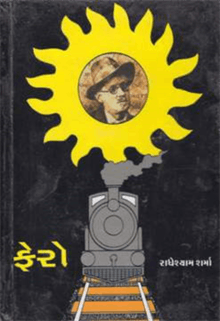Fero (novel)
Fero (Gujarati: ફેરો) (English: The Trip) is a Gujarati novel written by Radheshyam Sharma. It was published in 1968 by Rekha Prakashan in Ahmedabad.[1] It is acclaimed in Gujarati literature for its experimental nature[2] and is considered a literary milestone among modern Gujarati authors.[3] It was followed by Sharma's similarly exploratory novel, Swapnatirtha.[4][5] The name of this novel is referenced in the title of Suman Shah's critical work Chandrakant Bakshi Thi Fero (1973).[6]
 book cover, 2007 ed. | |
| Author | Radheshyam Sharma |
|---|---|
| Original title | ફેરો |
| Country | India |
| Language | Gujarati |
| Genre | novel |
| Set in | Ahmedabad |
| Published | 1968 |
| Publisher | Rekha Prakashan, Ahmedabad |
| Media type | |
| Pages | 94 |
| 891.473 | |
| Followed by | Swapnatirtha (1979) |
Plot
A couple, who have a mute, only-child, take a long journey to the Sun temple with the hope that the gift of speech is granted to their child. The trip is an attempt to appease their God. The mother is hopeful at the start of the journey, but the child is lost as the train pulls out of the final station before the destination. In an attempt to stop the train, the father raises his hand to pull the chain but hesitates before doing so. The story is written from the father's perspective, and the reader is only privy to his observations and reactions.[7][8]
The novel is narrated in the first person, beginning with the family's departure and ending before the journey's completion.
Theme
The novel is centred on the theme of human consciousness. It delves into the complexity of thought and awareness as the family struggles to complete their journey.[9]
Criticism
Chandrakant Sheth, a Gujarati critic, considers the prose of the novel too aristocratic in nature.[10]
References
- Books India. National Book Trust. 1972. p. 56.
- K. M. George (1992). Modern Indian Literature, an Anthology: Surveys and poems. Sahitya Akademi. p. 141. ISBN 978-81-7201-324-0.
- Jhaveri, Dileep. "Celebrating Gujarati Prose". Muse India. ISSN 0975-1815. Retrieved 2017-01-11.
- K. M. George (writer) (1992). Modern Indian Literature, an Anthology: Surveys and poems. New Delhi: Sahitya Akademi. p. 141. ISBN 978-81-7201-324-0. Retrieved 11 January 2017.
- Nalini Natarajan; Emmanuel Sampath Nelson (1996). Handbook of Twentieth-century Literatures of India. Greenwood Publishing Group. pp. 122–. ISBN 978-0-313-28778-7.
- Mohan Lal (1992). Encyclopaedia of Indian Literature: Sasay to Zorgot. New Delhi: Sahitya Akademi. p. 3946. ISBN 978-81-260-1221-3. Retrieved 12 January 2017.
- P. K. Rajan (1989). The Growth of the Novel in India, 1950-1980. New Delhi: Abhinav Publications. p. 75. ISBN 978-81-7017-259-8. Retrieved 11 January 2017.
- Brahmabhatt, Prasad (2010). અર્વાચીન ગુજરાતી સાહિત્યનો ઈતિહાસ - આધુનિક અને અનુઆધુનિક યુગ (History of Modern Gujarati Literature – Modern and Postmodern Era) (in Gujarati). Ahmedabad: Parshwa Publication. pp. 184–185. ISBN 978-93-5108-247-7.
- Gujarat. Smt. Hiralaxmi Navanitbhai Shah Dhanya Gurjari Kendra, Gujarat Vishvakosh Trust. 2007. p. 404.
- Talpada, Hasit. "Chapter 3: Radheshyam Sharmani Navalkathanu Gadya". Aadhunik Navalkathanu Gadhya Ek Abhyas Suresh Joshi Madhuray Ravji Patel Radheshyam Sharma ni Mukhya Navalo ne Aadhare (PDF) (Thesis). Sardar Patel University. hdl:10603/98020. Retrieved 17 January 2017.